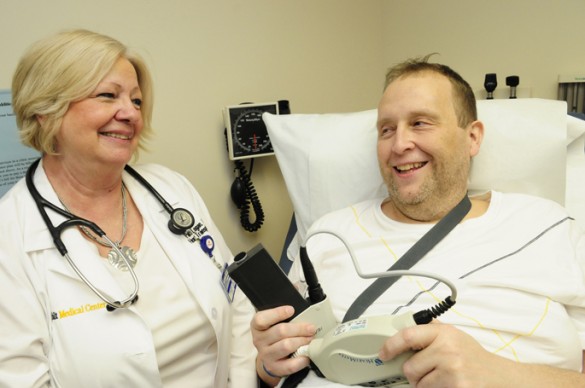The state of Michael Stanbery’s health was shocking.
His internal defibrillator was delivering painful shocks weekly in an attempt to correct his arrhythmia, known as ventricular tachycardia (VT). When the defibrillator detected VT, it sent up to 800 volts in one-tenth of a second to try to correct it.

“It felt like a horse kicking me in the chest every time,” said Stanbery, 48, of Morristown, Tenn.
In addition to his internal defibrillator, Stanbery, who was diagnosed with cardiomyopathy 12 years ago, has a left ventricular assist device (LVAD) to help support the work of his failing heart while he waits for a transplant.
Typically, VT can be cured through ablation, which uses radio frequency to heat the muscle fibers in the left ventricle. However, the presence of an LVAD makes this procedure very difficult because the physician has to manipulate the ablation catheter around the LVAD, an implantable mechanical pump with a propeller that helps pump blood from the ventricles to the rest of the body.
“About 35 percent of patients with LVADs have sustained VT requiring their internal device to deliver therapy. While it comes with pain, we have typically let the device do its work because there were no other options,” said Christopher Ellis, M.D., assistant professor of Medicine. “It’s vital that we prevent these patients from getting recurrent defibrillator shocks. They are painful and associated with shortened survival.”
Recently, Ellis performed ablation on Stanbery, the first LVAD patient to undergo the procedure at Vanderbilt.
“Mr. Stanbery had essentially been in sustained VT for several weeks prior to his ablation, with the ICD shock temporarily turned off. There was evidence in his blood tests that his kidneys and liver were failing from critical heart failure,” Ellis said.
Ellis inserted a platinum-tipped catheter in Stanbery’s femoral vein, and manipulated it through the right atrium, into the left atrium, and down through the mitral valve into the left ventricle.
The catheter delivered an electrical current that vibrated ions in the heart muscle, heating the tissue and killing the muscle responsible for the VT.
All the while, Ellis was keeping an eye on the LVAD via X-ray guidance to make sure the catheter did not get near the propeller as it continued to do the work of Stanbery’s heart.
“When Mr. Stanbery came in, he felt bad. The amount of blood flow going around his body was significantly lower when he was in VT. As soon as we converted him to normal rhythm, his pump flows went up and he felt great the next day,” Ellis said.
“He should have a very high success rate. He should live without any more VT or defibrillator shocks until his transplant.”















